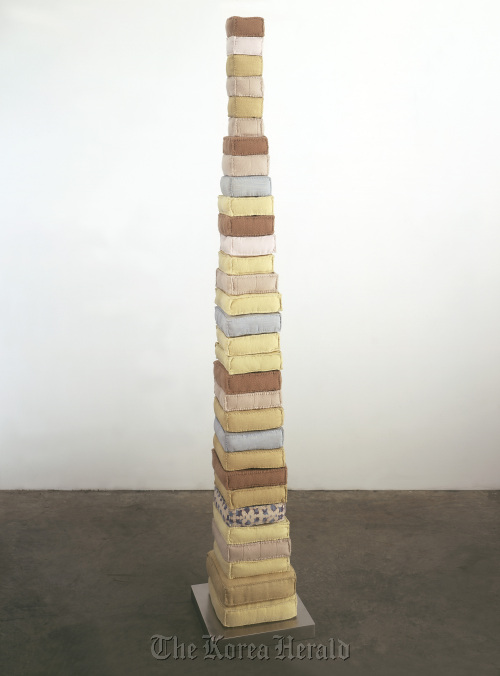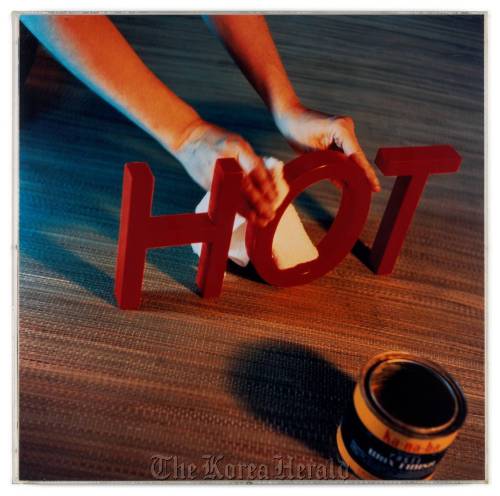PKM Trinity Gallery offers top artists’ conceptual contemporary artworks from 1960s to present
Martin Creed crumpled up a piece of white paper into a ball. People call it art. Tracey Emin scribbled one single sentence, “Only God Knows I’m Good,” using snow white neon. People also call that art.
Since when did art become something so difficult to understand and not something simply beautiful to enjoy?
The exhibition “TEXT/VIDEO/FEMALE: Art after ‘60s” currently running at PKM Trinity Gallery in Cheongdam-dong, southern Seoul, answers that it became so, on a significant scale, after the 1960s.
While museums and collectors of contemporary art usually define their collections as artworks produced since World War II, art insiders also agree that more significant changes in art happened in the 1960s. Since then, artists started to refuse the legitimacy of traditional fine art and pursued brand new media and subjects.
Martin Creed crumpled up a piece of white paper into a ball. People call it art. Tracey Emin scribbled one single sentence, “Only God Knows I’m Good,” using snow white neon. People also call that art.
Since when did art become something so difficult to understand and not something simply beautiful to enjoy?
The exhibition “TEXT/VIDEO/FEMALE: Art after ‘60s” currently running at PKM Trinity Gallery in Cheongdam-dong, southern Seoul, answers that it became so, on a significant scale, after the 1960s.
While museums and collectors of contemporary art usually define their collections as artworks produced since World War II, art insiders also agree that more significant changes in art happened in the 1960s. Since then, artists started to refuse the legitimacy of traditional fine art and pursued brand new media and subjects.

“Half a century has passed since we have started to use the term ‘contemporary art.’ What we wanted to point out, at this point, is that various genres of contemporary art share a common idea: ‘conceptual art.’ Though it has been there for a long time, it is something that the public still finds difficult to understand,” Park Kyung-mee, director of the gallery, told the press last week.
Mind-boggling artworks by 11 major contemporary artists ― Louise Bourgeois, Martin Creed, Tracey Emin, Dan Graham, On Kawara, Paul McCarthy, Bruce Nauman, Paik Nam-june, Richard Prince, Ed Ruscha, Lawrence Weiner ― are on display at the show.

It is quite an unfamiliar sight to see artworks by such big name artists all clustered together for a collective exhibition under a theme meaningful to art history at a private gallery, since these more often hold solo shows.
“They are all commercially established artists whose works are highly priced. We wanted to offer a chance to look back on contemporary art up to the present, as thoroughly as our gallery could,” said Park.
There are no separate rooms but the exhibition offers three keywords to understand conceptual art ― text, video and female.
Many texts are found on the walls ― either on canvases, fabrics or neon signs. As simple as they seem, there could be much more to them, depending on whether you just read and pass by them or take time to ponder them. Of course, it depends on the artists’ intentions, too.
The date “June 24, 1992” written on green canvas by Japanese artist On Kawara, for example, has so many underlying messages ― some of which can be identified by looking at the back of the work. Meanwhile, meaningful words like “Without” or “Thoughts” turn out to be futile when used by U.S. artist Ed Ruscha because he was only interested in the shape of the letters to use them as a part of his paintings.
Several video footages, including one by U.S. artist Paul McCarthy which shows strange performances by eerie Disney characters, or the one by Dan Graham, also from the U.S., in which he installed a camera behind a glass window and observed the passers-by, are screened downstairs.
Reflecting the emergence of female artists since the 1960s, the exhibition dedicated a relatively large space for the late French artist Louise Bourgeois and Emin, one of the few female Young British Artists.
The exhibition runs through March 23 at PKM Trinity Gallery in Cheongdam-dong, southern Seoul. For more information, call (02) 515-9496~7 or visit www.pkmgallery.com.
By Park Min-young (claire@heraldcorp.com)











![[Today’s K-pop] BTS pop-up event to come to Seoul](http://res.heraldm.com/phpwas/restmb_idxmake.php?idx=644&simg=/content/image/2024/04/17/20240417050734_0.jpg&u=)




![[KH Explains] Hyundai's full hybrid edge to pay off amid slow transition to pure EVs](http://res.heraldm.com/phpwas/restmb_idxmake.php?idx=652&simg=/content/image/2024/04/18/20240418050645_0.jpg&u=20240418181020)

![[Today’s K-pop] Zico drops snippet of collaboration with Jennie](http://res.heraldm.com/phpwas/restmb_idxmake.php?idx=642&simg=/content/image/2024/04/18/20240418050702_0.jpg&u=)